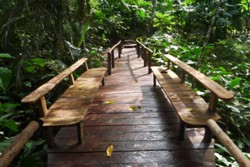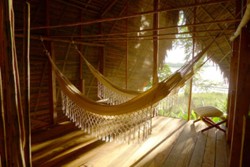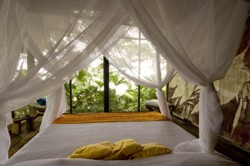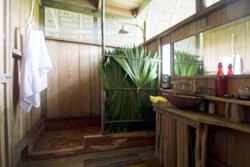

Destinations
Experiences
 |
L A
D A T C O T O U R
S |
 |
||||||||
| HOME | South America | Falkland Islands | Antarctica | Unique Destinations |
Unique Experiences |
Newsstand | ||||
|
Calanoa Amazonas near Leticia, Colombia |
|
 |
 |
 |
 |
ABOUT CALANOA AMAZONAS - in their own words:
The Calanoa Project is an initiative by Marlene and Diego Samper that aims to contribute to the conservation of biological and cultural diversity in the Amazon region by providing a setting that integrates art, design, architecture, scientific research, communication, community education and sustainable tourism.It is based in a private natural reserve located on the banks of the Amazon River, 60 km west of the Colombian town of Leticia, beside the Amacayacu Natural Park and close to indigenous villages of the Tikuna, Cocama, Huitoto and Bora people. The Calanoa Project is aiming to work with the indigenous villages that are around the Amacayacu Natural park, supporting educational processes, conservation of biological resources, sustainable economic practices and the preservation of ancestral knowledge and cultural practices.
Calanoa is a place of encounters, a permanent forum for art, design and science, through residencies, workshops, encounters and international meetings.
Calanoa provides an ideal setting for the development and implementation of innovative design for the humid tropics. The building of the settlement has been a laboratory for natural and sustainable architecture, research into traditional techniques, local materials, wood and natural fibers, raw earth and ceramic, landscape architecture, alternative energies and water treatment.
The hub of this conservation project is 125 acres of land - the starting point for a natural reserve and a collection of tropical fruits, medicinal and useful Amazonian plants for a self-sufficient settlement. Hundreds of hardwood trees, fruits and palms have been planted in order to supply food, fibers and building materials.
A grid of trails and wildlife observation towers facilitates the study and contemplation of the forest for researchers and visitors.
ABOUT CALANOA LODGE - in their own words:
Calanoa Jungle Lodge offers a space for the traveler who is in search of a vital experience, who is in a journey of discovery. Our travel plans and workshops propose an experience of the rainforest through the senses and a creative dialogue with the inhabitants. ÂThe Calanoa Natural Reserve is at the very heart of the Amazon forest, yet easy to access, and its surroundings are an endless source of marvel. It is a low-impact, small-scale settlement. If you are planning to visit us, please book in advance, as lodging is limited.
The visitors’ cabins have a bedroom and bathroom on the first floor and a loft, with a capacity for 6 people each. The cabins are fully covered with mosquito screen, and each bed has its own mosquito net for extra protection from bugs. A board path connects the cabins with the dining/social pavilion, and has an observation platform ideal for birds and monkeys watching.
The social pavilion has a central screen tent with a big dining table, and it is located in a way that makes the most of the view of the river. Around it there are hammock swings and seats for guests to relax. A wooden deck connects with the kitchen pavilion, a generous space open for the guests to visit and participate of the preparation of food.
Calanoa's cuisine is a fusion of local Amazonian traditions with Brazilian, Colombian and Peruvian cuisine, put together by the owners’ creativity. Organic and fresh local produce, fire wood cooking and our famous freshly baked bread contribute to a delightful experience.
The buildings have been designed by Diego Samper combining traditional techniques with a contemporary approach, a sustainable architecture that uses local materials and resources. The woven palm roofs are beautiful and fresh, walls are minimal to improve air circulation, and the structures are built on stilts to elevate them from the ground, allowing for better views and increasing air circulation.